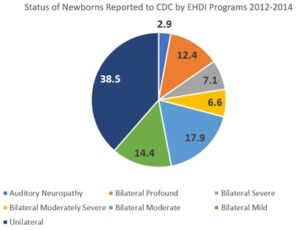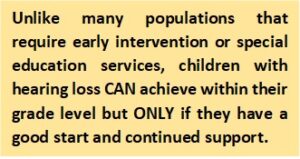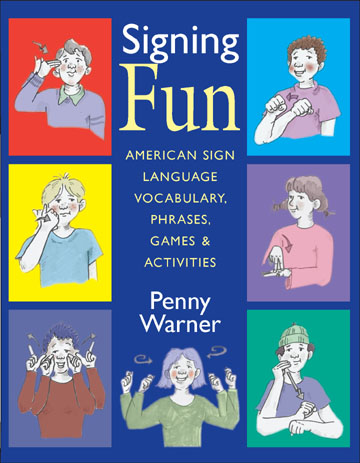Related Products
For Parents
Related Teacher Tools Takeout Items
Early Intervention Materials on Tap
Who are our babies with hearing loss? Fewer than 15% of the babies identified by Early Hearing Detection and Intervention (EHDI) programs have bilateral profound hearing loss (deaf) and more than 50% have mild bilateral or unilateral hearing loss. The distribution of degree of hearing loss in diagnosed infants is depicted in the following figure. Fewer than 1 in 20 newborns with congenital hearing loss have two parents who are hard of hearing or deaf. 1 Therefore, most families of these children have little or no knowledge of hearing loss and its potential impact on language and speech development, social skills, and future academic and life success. The following information will share recent research findings about the needs of these children and available materials to assist early interventionists and families facilitate good early childhood development outcomes.
 The 2015 Outcomes of Children with Hearing Loss research2 on children with permanent mild to severe hearing loss (25-75 dB) was a large-scale longitudinal study that followed children from six months of age to seven years old. There were 317 children who were hard of hearing and a comparison group of 117 children without hearing loss from 17 states. Almost all had permanent bilateral hearing loss and hearing aids. Three fourths were identified through newborn hearing screening. Assessment occurred every 6 months from age 6-24 months and annually thereafter to groups of children.
The 2015 Outcomes of Children with Hearing Loss research2 on children with permanent mild to severe hearing loss (25-75 dB) was a large-scale longitudinal study that followed children from six months of age to seven years old. There were 317 children who were hard of hearing and a comparison group of 117 children without hearing loss from 17 states. Almost all had permanent bilateral hearing loss and hearing aids. Three fourths were identified through newborn hearing screening. Assessment occurred every 6 months from age 6-24 months and annually thereafter to groups of children.
Summary of OCHL Findings:
- 15% of the children had unstable hearing that declined over the study period
- Over half of the children had hearing aid fittings that did not meet prescriptive targets and 35% of the total had below average audibility due to poor hearing aid fit; only 65% of the children had adequate aided audibility of speech
- The majority wore their hearing aids at least 8 hours per day, with young children wearing just a few hours, increasing wear time gradually until they achieved more usage in preschool
- 10-15% had declining or limited hearing aid wear
- Children with mild to severe hearing loss, on average, showed depressed language levels compared with peers with normal hearing who were matched on age and socioeconomic status; amount of language delay increased with greater severity of hearing loss
- Better audibility with hearing aids was associated with faster rates of language growth in the preschool years.
- Children fit early with hearing aids had better early language achievement than children fit later. Any degree of hearing loss, even mild loss, can place children at risk for learning issues. The risk can be minimized with early and aggressive intervention.
In general, this collection of articles has now proven what experienced early interventionists know – for children who are hard of hearing, hearing aids need to be well fit and worn consistently and families need to know how to communicate effectively with their child to maximally develop spoken language. The richness of the parent’s talk with the child influences the child’s language outcome. This ‘formula for success’ for children who are hard of hearing is now supported by strong research.2 To accomplish these ends requires very knowledgeable interventionists who have the time to provide continued support to families throughout early childhood and the involvement of someone with expertise in the educational impact of hearing loss once the child is in school.
 The National Center for Hearing Assessment and Management (NCHAM) reports that detecting and treating hearing loss at birth for one child saves $400,000 in special education costs by the time that child graduates from high school.3 The amount saved can only be realized with the investment of early, appropriate services from experienced interventionists working to support families over time.
The National Center for Hearing Assessment and Management (NCHAM) reports that detecting and treating hearing loss at birth for one child saves $400,000 in special education costs by the time that child graduates from high school.3 The amount saved can only be realized with the investment of early, appropriate services from experienced interventionists working to support families over time.
Early Intervention “Curriculums”
There is no single resource that will impart all the knowledge needed to adequately support families of young children with hearing loss. The interventionist must have a sufficient background in hearing loss, understanding audibility/speech perception, language development, the continuum of communication choices, and adult learning – as a start. The following are resources that have materials that can be easily shared with families to enhance intervention. The best intervention is reactionary, in response to the current concerns of the family, that builds skills over time in relation to the child and family’s needs. That said, it is very helpful to have resources at hand to draw from as you respond to different family learning styles and needs.
SKI*HI is perhaps the oldest and most recognized EI curriculum resource, especially for persons just starting to work with families of young children with hearing loss. The 2-volume, 2200-page resource includes information suitable to all degrees of hearing loss and exploration of and starting skill building in all communication choices. The visuals provided in the SKI*HI curriculum are something that interventionists use all the time!
EI Resources for Families Choosing to Use ASL
Gallaudet has some informational webcasts that will be of benefit to early intervention providers assisting families in learning sign language to use with their young children. Refer to the list of EI webcasts, online learning resources and publications here.
To learn any language, a child must be surrounded by fluent language users who dynamically involve the child in 2-way communication. Therefore, teachers of the deaf/hard of hearing who are highly skilled in the use of sign language and/or adults who have hearing loss and use sign language (Deaf Role Models) are the optimal choice for facilitating the family’s effective use of sign language.
Referencing sign language dictionaries such as Signing Fun, the Gallaudet Children’s Dictionary, and ASL Basics for Hearing Parents of Deaf Children is often very useful to families. It is important for EI providers to understand the developmental hierarchy for learning sign language. ASL developmental hierarchy information can be found at the end of this White Paper.
EI Resources for Families Choosing to Use Listening and Spoken Language
Listen Little Star is a tried and true resource from Australia that has 12 lessons for the family of infants (0-12 months). It is easy to use and has a DVD with professional grade video clips to accompany each lesson.
The Learn To Talk Around The Clock Toolbox is organized around a set of principles and provides hundreds of suggestions for natural practice in the family’s home or child care setting in an orderly presentation of skills known as “Signature Behaviors.” Author Karen Rossi, DHH teacher and LSLS, has an incredibly helpful website to support families, early interventionists, childcare and into preschool. The Language Development Knowledge Cards have many applications.
The Listening Room (Advanced Bionics AB4Kids) features three sections with content created specifically for age groups: Infants & Toddlers, Kids, Teens & Adults. Register to be able to see and download free activities and resources to support the development of speech, language, and listening skills. AB4Kids also offers the Baby Beats (video) app to develop listening and communication skills in young children. They also provide wonderful resources for preschool and school-aged children.
Cochlear Corporation has provided extensive, incredible resources with Sound Foundation for Babies and Sound Foundation for Toddlers. Designed for 12 months and up, the skills for babies start at a beginning auditory awareness level are applicable to children who are hard of hearing identified in the first few months along with those who are recently implanted. Babies Babble, Toddlers Talk, and Children Chatter are all videos that support the Listen, Learn, and Talk book. The Cochlear suite of materials is helpful to any interventionist or teacher working with children with useable residual hearing. There are also resource for parents of school-age children and could selectively provide some basic information for teachers. It is great to have this bank of resources videos at your fingertips.
MED-EL cochlear implant company also provides resources to purchase that will support listening and communication development. Their free offerings include Ling Cards (set of 7 cards, 3” x 5”), Little Listeners comprehensive guide for preverbal speech, language and auditory development, Little Listeners in Spanish and other resources that can be ordered for free, or downloaded as PDFs.
Early Intervention Materials
Early Language Development Handouts and Activities with Bonus CD This inexpensive resource provides 25 informational and activity-based handouts that will help you tell parents and caregivers at home how they can stimulate language development in their young ones. Copy the black and white handouts or print color versions from the CD.
Early Intervention Kit – Teaching Guide, Activities Book, Sign Language Cards While this is not a DHH-specific resource, this kit has the essential information and tools for successful early intervention services. Effectively address assessment, intervention, and documentation. The Activities Book is a gold mine of intervention objectives, goals, and specific suggested activities, for Pre-Linguistic Skills, Expressive Language Skills, Receptive Language Skills and Sound Production Development.
Listen Little Star is for families of infants newly diagnosed with hearing loss. It is excellent for families to obtain and use independently as a supplement to their early services. It is even more effective when used as a family-friendly guide to early intervention whether used by a provider with limited background in DHH or a veteran early intervention DHH teacher. This colorful 160+ page guide is divided into 12 lessons and also includes an extensive Baby Response Checklist data gathering tool and other resource materials at the end.
A DVD with professionally recorded video lessons provides a description and video showing the lesson being done by a parent and child. It is an excellent way to teach the skill in the printed or digital guide.
Achieving Effective Hearing Aid Use in Early Childhood
The purpose of this guide is to further the understanding of children’s development, how developmental stages will affect hearing aid wear, and what families and early intervention teachers can do to achieve full-time hearing aid wear. By using the information in this guide, hearing aid retention accessories and specific age-appropriate strategies, it is hoped that families will be better prepared to manage their child’s hearing aid wear. The guide is 88 pages long and is available in digital or paper versions. Information written in this guide is directed toward parents, which makes it ideal to use as an intervention guide while providing services to families of infants, toddlers and transitioning preschoolers.
The Developing Child with Unilateral Hearing Loss
20%-30% of all infants diagnosed with hearing loss have unilateral hearing loss (UHL). The result is hundreds of
families of babies with unilateral hearing loss who are seeking assistance to understand what the hearing loss may mean to their child’s future and to receive direction on how they can best influence their child’s success.
The publication is a step-by-step guide to early intervention for children with UHL. It is available in digital and paper versions. The early intervention material is based on a 100-slide PowerPoint Presentation that explains what should be discussed at each of the first 5+ early intervention sessions along with family-friendly information to address each key point. Handouts have been drawn from the slide groups to serve as a summary of key concepts.
Social-Emotional Evaluation/Assessment Measure (SEAM)
The SEAM is an in-depth, easy-to-use tool, to reliably assess and monitor social-emotional development in
infants, toddlers, and preschoolers at risk for delays or challenges. The two-part SEAM™ assessment reveals
detailed qualitative information on children’s social-emotional competence – and identifies their caregivers’ strengths and areas of need. Easy to learn and implement, SEAM can be used by a wide variety of early childhood professionals, including those with little or no training in mental-health or behavioral interventions.
APPS!
There are literally thousands of apps available, with varying quality and effectiveness. Without any recommendations, the following are some resources regarding apps for babies/young children with hearing loss:
References
- 1. White, K. R. (2018). Demographic Considerations in Serving Children who are Hard of Hearing or Deaf. Journal of Early Hearing Detection and Intervention, 3(2), 14-17.
- 2. Ear and Hearing, November/December 2015, Volume 36, Supplement 1 Conclusions article
- 3. Advocacy Facts. NCHAM handout.

